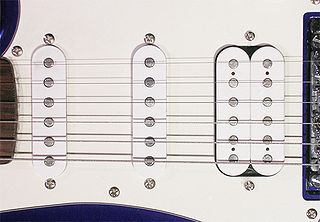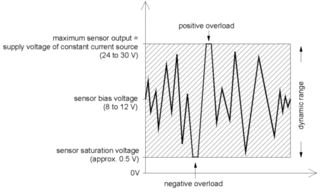Related Research Articles

Sonar is a technique that uses sound propagation to navigate, measure distances (ranging), communicate with or detect objects on or under the surface of the water, such as other vessels.

Ultrasound is sound with frequencies greater than 20 kilohertz. This frequency is the approximate upper audible limit of human hearing in healthy young adults. The physical principles of acoustic waves apply to any frequency range, including ultrasound. Ultrasonic devices operate with frequencies from 20 kHz up to several gigahertz.
A hydrophone is a microphone designed to be used underwater for recording or listening to underwater sound. Most hydrophones are based on a piezoelectric transducer that generates an electric potential when subjected to a pressure change, such as a sound wave.

A microphone, colloquially called a mic, is a transducer that converts sound into an electrical signal. Microphones are used in many applications such as telephones, hearing aids, public address systems for concert halls and public events, motion picture production, live and recorded audio engineering, sound recording, two-way radios, megaphones, and radio and television broadcasting. They are also used in computers and other electronic devices, such as mobile phones, for recording sounds, speech recognition, VoIP, and other purposes, such as ultrasonic sensors or knock sensors.

Echo sounding or depth sounding is the use of sonar for ranging, normally to determine the depth of water (bathymetry). It involves transmitting acoustic waves into water and recording the time interval between emission and return of a pulse; the resulting time of flight, along with knowledge of the speed of sound in water, allows determining the distance between sonar and target. This information is then typically used for navigation purposes or in order to obtain depths for charting purposes.
A transducer is a device that converts energy from one form to another. Usually a transducer converts a signal in one form of energy to a signal in another. Transducers are often employed at the boundaries of automation, measurement, and control systems, where electrical signals are converted to and from other physical quantities. The process of converting one form of energy to another is known as transduction.

Active noise control (ANC), also known as noise cancellation (NC), or active noise reduction (ANR), is a method for reducing unwanted sound by the addition of a second sound specifically designed to cancel the first. The concept was first developed in the late 1930s; later developmental work that began in the 1950s eventually resulted in commercial airline headsets with the technology becoming available in the late 1980s. The technology is also used in road vehicles, mobile telephones, earbuds, and headphones.

A pickup is a transducer that captures or senses mechanical vibrations produced by musical instruments, particularly stringed instruments such as the electric guitar, and converts these to an electrical signal that is amplified using an instrument amplifier to produce musical sounds through a loudspeaker in a speaker enclosure. The signal from a pickup can also be recorded directly.

Ocular tremor is a constant, involuntary eye tremor of a low amplitude and high frequency. It is a type of fixational eye movement that occurs in all normal people, even when the eye appears still. The frequency of ocular microtremor has been found to range from 30 Hz to 103 Hz, and the amplitude is approximately four thousandths of a degree.

A piezoelectric sensor is a device that uses the piezoelectric effect to measure changes in pressure, acceleration, temperature, strain, or force by converting them to an electrical charge. The prefix piezo- is Greek for 'press' or 'squeeze'.

A charge amplifier is an electronic current integrator that produces a voltage output proportional to the integrated value of the input current, or the total charge injected.
The mechanomyogram (MMG) is the mechanical signal observable from the surface of a muscle when the muscle is contracted. At the onset of muscle contraction, gross changes in the muscle shape cause a large peak in the MMG. Subsequent vibrations are due to oscillations of the muscle fibres at the resonance frequency of the muscle. The mechanomyogram is also known as the phonomyogram, acoustic myogram, sound myogram, vibromyogram or muscle sound.

Ultrasonic transducers and ultrasonic sensors are devices that generate or sense ultrasound energy. They can be divided into three broad categories: transmitters, receivers and transceivers. Transmitters convert electrical signals into ultrasound, receivers convert ultrasound into electrical signals, and transceivers can both transmit and receive ultrasound.
Electromagnetic acoustic transducer (EMAT) is a transducer for non-contact acoustic wave generation and reception in conducting materials. Its effect is based on electromagnetic mechanisms, which do not need direct coupling with the surface of the material. Due to this couplant-free feature, EMATs are particularly useful in harsh, i.e., hot, cold, clean, or dry environments. EMATs are suitable to generate all kinds of waves in metallic and/or magnetostrictive materials. Depending on the design and orientation of coils and magnets, shear horizontal (SH) bulk wave mode, surface wave, plate waves such as SH and Lamb waves, and all sorts of other bulk and guided-wave modes can be excited. After decades of research and development, EMAT has found its applications in many industries such as primary metal manufacturing and processing, automotive, railroad, pipeline, boiler and pressure vessel industries, in which they are typically used for nondestructive testing (NDT) of metallic structures.

A piezoelectric accelerometer is an accelerometer that employs the piezoelectric effect of certain materials to measure dynamic changes in mechanical variables.

Tensiomyography(TMG) is a measuring method for detection of skeletal muscles' contractile properties. Tensiomyography assesses muscle mechanical response based on radial muscle belly displacement induced by a single electrical stimulus. It is performed using the TMG S2 system. A tensiomyography measurement instrument includes an electrical stimulator and data acquisition subunit (1), a digital sensor (2), a tripod with manipulating hand (3), and muscle electrodes (4) that work with an essential software interface installed on a PC.
Electrical impedance myography, or EIM, is a non-invasive technique for the assessment of muscle health that is based on the measurement of the electrical impedance characteristics of individual muscles or groups of muscles. The technique has been used for the purpose of evaluating neuromuscular diseases both for their diagnosis and for their ongoing assessment of progression or with therapeutic intervention. Muscle composition and microscopic structure change with disease, and EIM measures alterations in impedance that occur as a result of disease pathology. EIM has been specifically recognized for its potential as an ALS biomarker by Prize4Life, a 501(c)(3) nonprofit organization dedicated to accelerating the discovery of treatments and cures for ALS. The $1M ALS Biomarker Challenge focused on identifying a biomarker precise and reliable enough to cut Phase II drug trials in half. The prize was awarded to Dr. Seward Rutkove, chief, Division of Neuromuscular Disease, in the Department of Neurology at Beth Israel Deaconess Medical Center and Professor of Neurology at Harvard Medical School, for his work in developing the technique of EIM and its specific application to ALS. It is hoped that EIM as a biomarker will result in the more rapid and efficient identification of new treatments for ALS. EIM has shown sensitivity to disease status in a variety of neuromuscular conditions, including radiculopathy, inflammatory myopathy, Duchenne muscular dystrophy, and spinal muscular atrophy.

Vibration calibrators , sometimes also called reference shakers, are electromechanical instruments which enable calibration of vibration sensors and measuring instruments to traceable standards. They produce sinusoidal mechanical vibration signals with known amplitudes and frequencies. The vibrating part of the instrument is usually a cylindrical steel stud with an internal thread for attachment of the test object. An electrodynamic or piezoelectric actuator system is used to produce the vibrations. With older instruments it was necessary to adjust the vibration amplitude according to the weight of the test object. However, modern instruments contain a built-in reference accelerometer and closed-loop control, with which the amplitude is kept constant up to a maximum specified weight of test object. Older models can be used to calibrate objects weighing up to a maximum of approximately 100 g, whereas the latest instruments can work stably with test objects weighing over 500 g.
The Gruppenhorchgerät was a hydrophone array which was used on Nazi Germany's U-boats in World War II.

The abbreviation IEPE stands for Integrated Electronics Piezo-Electric. It characterises a technical standard for piezoelectric sensors which contain built-in impedance conversion electronics. IEPE sensors are used to measure acceleration, force or pressure. Measurement microphones also apply the IEPE standard. Other proprietary names for the same principle are ICP, CCLD, IsoTron or DeltaTron.
References
- 1 2 "Archived copy". Archived from the original on 2011-06-04. Retrieved 2009-09-07.
{{cite web}}: CS1 maint: archived copy as title (link) - ↑ Orizio, Claudio; Gobbo, Massimiliano; Diemont, Bertrand; Esposito, Fabio; Veicsteinas, Arsenio (2003). "The surface mechanomyogram as a tool to describe the influence of fatigue on biceps brachii motor unit activation strategy. Historical basis and novel evidence". European Journal of Applied Physiology. 90 (3–4): 326–336. doi:10.1007/s00421-003-0924-1. PMID 12923643. S2CID 6031573.
It is important to underline here that the term "surface mechanomyogram" was suggested during a CIBA Foundation Symposium in 1995 to overcome the terminological confusion caused by the habit of identifying the phenomenon with the electrical signal produced by different transducers (microphones, accelerometers, piezoelectric transducers, LVDs, etc.) instead of with its mechanical origin
- 1 2 Beck, Travis W.; Housh, Terry J.; Cramer, Joel T.; Weir, Joseph P.; Johnson, Glen O.; Coburn, Jared W.; Malek, Moh H.; Mielke, Michelle (19 December 2005). "Mechanomyographic amplitude and frequency responses during dynamic muscle actions: a comprehensive review". BioMedical Engineering OnLine. 4 (1): 67. doi: 10.1186/1475-925X-4-67 . PMC 1343566 . PMID 16364182.

- ↑ Grimaldi, Francesco Maria (1665). Physico-mathesis de lumine, coloribus, et iride, aliisque adnexis libri duo. Bologna. p. 383.
- ↑ Wollaston, WH (1810). "On the duration of muscle action". Philosophical Transactions of the Royal Society of London. 100: 1–5. doi: 10.1098/rstl.1810.0002 .
- ↑ Erman, P (1812). "Einige Bemerkungen uber Muscular-Contraction". Annalen der Physik. 40 (1): 1–30. Bibcode:1812AnP....40....1E. doi:10.1002/andp.18120400102.
- ↑ Stokes, Maria; Blythe, Max (2001). Muscle Sounds in physiology, sports science and clinical investigation. Oxford: Medintel. ISBN 978-0-9540572-0-6.
- 8. Harrison, A.P., Danneskiold-Samsøe, B., Bartels, E.M. - Portable acoustic myography – a realistic noninvasive method for assessment of muscle activity and coordination in human subjects in most home and sports settings. Physiol Rep. Jul 2013; 1(2): e00029. Published online Jul 10, 2013. http://physreports.physiology.org/content/1/2/e00029